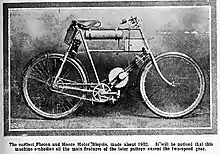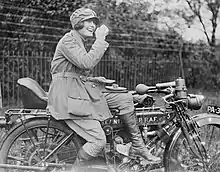Phelon & Moore
Phelon & Moore manufactured motorcycles in Cleckheaton, Yorkshire, England from 1904 to 1967, particularly those under the Panther marque.[1] They became identified with a design of motorcycle which had a large sloping 40-degree single-cylinder engine as a stressed member of the frame. This design spanned the entire history of the company, starting with a 500 cc model and ending with a 645 cc model.[2]
| Industry | Motorcycles |
|---|---|
| Founded | 1904 |
| Defunct | 1967 |
| Fate | Acquired, ultimately, by IMI plc |
| Headquarters | Cleckheaton, Yorkshire, UK |
| Products | Panther marque |

Precursor
The sloping stressed member concept was patented in 1901 by Joah ("John") Carver Phelon and his nephew Harry Rayner (Patent GB190103516).[3] Phelon & Rayner made the first chain-driven motorcycle in 1900. The Phelon & Rayner 1.75 hp machines were only in production until 1903, but they also licensed the design to Humber Motorcycles, who produced motorcycles based on it from 1902 until 1906.[4] After Harry Rayner died in a car accident, Joah Phelon went into partnership with Richard Moore.[5]
P&M motorcycles

Phelon & Moore was established in 1904, and their motorcycles were branded as P&M. The 1905 P&M featured an inclined single cylinder 4-stroke engine as a stressed member in the frame with 2-speed gear and chain drive to the rear wheel,[6] it being the 'first completely chain driven motor cycle'.[7] P&M motorcycles competed in the first International Six Days Trial (ISDT) in 1913 (now called the International Six Days Enduro).[8] Three P&M motorcycles competed in the 1914 ACU six days trial, all 3.5 hp solo models (of 498cc).[9]
In July 1914 P&M revealed details of their prototype 90 degree V-twin, their first deviation from the single cylinder motor cycles for which they were known.[10] When the V-twin was launched in November 1914[11] it featured a four-speed gear, and was of 770cc, rated as 6 hp. It appears only a handful of the twin were built, though it appeared in catalogues until 1916.[12] The four-speed gear arrangement used on the V-twins was re-introduced for the single in 1922, and at the same time the engine capacity was increased from 499cc to 555cc.[7] This was the last model to carry the P&M name, later models being branded as Panther.
The Royal Flying Corps used P&M motorcycles during the First World War, keeping P&M busy throughout the conflict.[13] P&M were also selected as the suppliers when the Royal Armoured Corps added sidecars to their range of vehicles in 1922.[14]
Panther motorcycles
.jpg.webp)

The first Panther was launched in 1924, but the Phelon & Moore name was not dropped until somewhere around 1929.
In 1932 the Panther Model 100, an OHV 600 cc single, was launched. This was produced through to the sixties, ending its run as the 645 cc Panther Model 120 of 1967. This line of Panthers was the most famous of all Phelon & Moore models.[15]
These heavyweight big single-cylinder "slopers" were often described as "firing once every lamp-post" due to their low rpm. Promoted as "The Perfected Motorcycle" they were noted for innovation for most of their history. Panthers were often used for hauling sidecars, a role in which the high torque output of a high capacity single-cylinder engine with its large flywheels was well suited, but the popularity of sidecar outfits eventually waned.
The combination of the advent of cheap cars and the collapse of the British motorcycle industry brought production to an end. They are simple and fairly robust machines which inspire enormous enthusiasm in their owners. These factors, combined with relatively low cost, have resulted in a fair number of Panthers being still in use.
Phelon & Moore also produced a range of lightweight machines, also generally carrying the name Panther or Red Panther, using their own four-stroke single engines and Villiers two-stroke engines. The Red Panther was known for being the cheapest complete bike available in the thirties, priced at a fraction under £30.[16] In 1934 a 250 cc Red Panther won the Maudes Trophy.
The early postwar models (both Lightweight and Heavyweight) were fitted with air/oil damped Dowty "Oleomatic" telescopic forks.
During the scooter boom of the late 1950s, P & M imported a scooter (Scooterrot) and moped from French manufacturer Terrot, which were plagued with troubles. This gave P & M the chance to develop their own scooter, the Panther Princess, but it was not a success and helped bring about the demise of P & M as motorcycle manufacturers. In 1962 the receiver was called in, and production staggered on until 1966.
List of models
"Heavyweight"
Phelon & Rayner
- 1.75 hp Phelon & Rayner[17] (1901–1903)
Humber
- 1.5/1.7 hp Humber (1901–1903)
- 2.75 hp Humber Olympia (1902–1905)
- 4.5 hp Humber Olympia (1905)
Phelon & Moore
- 2.75 hp (1904–1906)
- 3.5 hp (1904–1907)
- First real heavyweight 412cc
- 3.5 hp Forecar (1904)
- 3.5 hp Standard (1908–1914)
- 465cc (1908–1912)
- 499cc (1913 – 1914 & 1920 1922)
- 3.5 hp Colonial (1911–1914)
- Heavier duty version
- military version produced during First World War
- 4.5 hp Model A (1922–1925)
- 555 cc, two speed gearbox and two speed primary with combination foot and hand gear change giving four gears.
Phelon & Moore race bikes
- TT Entrant (1925–1926, 1928)
- TT Replica (1926–1928)
- Cinder Track (1928)
- 185 lb dirt tracker
Panther
- Panther (1924–1929)
- Panther Standard (1927)
- Panther Cub (1927)
- Stripped down version of Standard
- Panther Model 1 (1928)
- Introduction of Model numbers
- Panther Model 1a (1928)
- Twin exhaust port model
- Panther Model 2 Standard (1928)
- Panther Model 3 (1928)
- 598 cc
- Panther Model 60 (1929–1935)
- A renamed Model 3 and subsequently the origin of the Model 100
- Panther Model 85 (1929–1930)
- 598 cc
- Panther Model 50 (1930–1935)
- 498 cc
- Panther Model 55 (1931–1935)
- 498 cc
- Panther Model 55
- 490 cc
- Panther Model 90 Redwing (1931–1938)
- 490 cc
- Panther Model 70 Express (1932)
- Panther Model 100 (1932–1963)
- 598 cc

.jpg.webp)
.jpg.webp)
- Panther Model 95 (1938–1939)
- Vertical engine – low production numbers
- 500 cc
- Panther Model 120 (1959–1966)
- 645 cc, effectively an enlarged Model 100[18]
Four-stroke lightweights
- Panther Panthette (1930) (250 cc unit construction transverse V-twin, unsuccessful, only Panther four-stroke twin made, rare)
- Pre-war 250s include:
- Model 30 (1932)
- Model 40
- Model 70 Redwing
- Red Panther Standard
- Red Panther Model 20 Deluxe
- Red Panther Model 20
- Post-war 250s include:
- Model 60
- Model 65
- Model 65 Deluxe

Two-stroke lightweights
(Villiers motors)
- Model 10/3 (1956–1960) (197 cc single; 3 gears)
- Model 10/4 (1956–1960) (197 cc single; 4 gears)
- Model 45 (1959–1964) (324 cc twin )
- Model 35 (1958 to 1966) (249 cc twin)[20]
Sources
- Jones, Barry M. The Panther Story. Panther Publishing Ltd., 1999, p. 1.
- "The Panther Page". Panther Owners Club. Retrieved 29 October 2006.
- "Triumph Motorcycles Timeline: The Early Years, 1883–1918". www.ianchadwick.com. Retrieved 28 October 2006.
- 1899 to 1910 An Interview with Bert Yates, The Motor Cycle, 7 July 1910, p628
- Chadwick, Ian (30 June 2001). "British motorcycle manufacturers". www.ianchadwick.com. Retrieved 28 October 2006.
- "Evolution of the motor cycle", Motor Cycle magazine, 1 June 1922, pp. 700–706
- "Motor Cycles at the Scottish Show", Motor Cycle magazine, 26 January 1922, p123
- "ISDT 1913 Onwards". Speed Track Tales. Archived from the original on 20 August 2007. Retrieved 28 October 2006.
- "Competitors in the ACU Six Days Trial", Motor Cycle magazine, 9 July 1914, p48
- "A new 750 Twin P.&M.", Motor Cycle, 23 July 1914, p123-124
- "The 6 h.p. P. & M. Twin", Motor Cycle, 19 November 1914, p557-558
- The Motor, Marine and Aircraft Red Book 1917, W. C. Bersey and A. Dorey, The Technical Publishing Company
- Jones, Barry M. The Panther Story. Panther Publishing Ltd., 1999, p. 54.
- Motor Cycle magazine, 30 March 1922, p416
- "Motorcycle: Panther". Is-it-a-lemon. Retrieved 28 October 2006.
- "Panther". Merlin Books. Archived from the original on 3 November 2005. Retrieved 28 October 2006.
- Fleming, Simon. "The Panther Page – Heavyweight Models – P&R". Panther Owners Club. Retrieved 20 October 2007.
- "The Panther Page – Heavyweight Models". Panther Owners Club. Retrieved 28 October 2006.
- "The Panther Page – 4 Stroke Lightweight Models". Panther Owners Club. Retrieved 28 October 2006.
- Fleming, Simon. "The Panther Page – Two Stroke Lightweight Models". Panther Owners Club. Retrieved 28 October 2006.